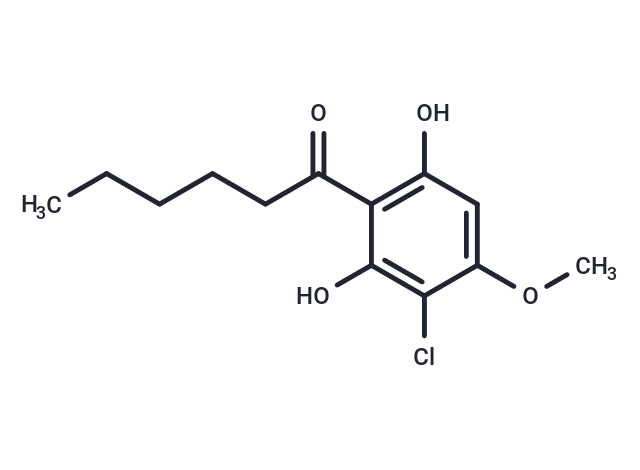Shopping Cart
Remove All Your shopping cart is currently empty
Your shopping cart is currently empty
DIF-3 is a chemical compound that acts by activating GSK-3β to facilitate the degradation of cyclin D1 and c-Myc, resulting in reduced expression levels of these proteins. In addition, DIF-3 inhibits Wnt/β-catenin signaling pathway-related proteins in DLD-1 cells. This compound exerts a potent antiproliferative effect on the HeLa human cervical cancer cell line by inducing cyclin D1 degradation and inhibiting cyclin D1 mRNA expression [1].

| Pack Size | Price | USA Warehouse | Global Warehouse | Quantity |
|---|---|---|---|---|
| 1 mg | $93 | In Stock | In Stock | |
| 5 mg | $247 | In Stock | In Stock | |
| 10 mg | $369 | In Stock | In Stock | |
| 25 mg | $619 | In Stock | In Stock | |
| 50 mg | $883 | In Stock | In Stock | |
| 100 mg | $1,190 | In Stock | In Stock | |
| 500 mg | $2,430 | - | In Stock | |
| 1 mL x 10 mM (in DMSO) | $227 | In Stock | In Stock |
| Description | DIF-3 is a chemical compound that acts by activating GSK-3β to facilitate the degradation of cyclin D1 and c-Myc, resulting in reduced expression levels of these proteins. In addition, DIF-3 inhibits Wnt/β-catenin signaling pathway-related proteins in DLD-1 cells. This compound exerts a potent antiproliferative effect on the HeLa human cervical cancer cell line by inducing cyclin D1 degradation and inhibiting cyclin D1 mRNA expression [1]. |
| In vitro | In this study, we examined the effects of six DIF analogues (DIF-1, DIF-2 (which has pentanone in place of hexanone), DIF-3 (dechlorinated form of DIF-1), 2-MIDIF-1 (2-methoxy isomer of DIF-1), DMPH (dechlorinated form of DIF-3), and THPH (4-hydroxy substitution of DMPH)) on DNA synthesis, cell growth, erythroid differentiation, and cytosolic free calcium concentration ([Ca2+]i) in human leukemia K562 cells. DIF-3 proved to be the most potent anti-leukemic agent among them, and the order of potency for causing growth inhibition, erythroid induction, and increases in [Ca2+]iTHPH in all the categories tested. [1] DIF-3 activates GSK-3beta to accelerate the proteolysis of cyclin D1 and that this mechanism is involved in the DIF-3-induced G(0)/G(1) arrest in mammalian cells.[2] |
| Molecular Weight | 272.72 |
| Formula | C13H17ClO4 |
| Cas No. | 113411-17-9 |
| Smiles | CCCCCC(=O)c1c(O)cc(OC)c(Cl)c1O |
| Storage | Powder: -20°C for 3 years | In solvent: -80°C for 1 year | Shipping with blue ice/Shipping at ambient temperature. | |||||||||||||||||||||||||||||||||||
| Solubility Information | DMSO: 90 mg/mL (330.01 mM), Sonication is recommended. | |||||||||||||||||||||||||||||||||||
| In Vivo Formulation | 10% DMSO+90% Corn Oil: 3.3 mg/mL (12.1 mM), Sonication is recommeded. Please add the solvents sequentially, clarifying the solution as much as possible before adding the next one. Dissolve by heating and/or sonication if necessary. Working solution is recommended to be prepared and used immediately. The formulation provided above is for reference purposes only. In vivo formulations may vary and should be modified based on specific experimental conditions. | |||||||||||||||||||||||||||||||||||
Solution Preparation Table | ||||||||||||||||||||||||||||||||||||
DMSO
| ||||||||||||||||||||||||||||||||||||
| Size | Quantity | Unit Price | Amount | Operation |
|---|

Copyright © 2015-2026 TargetMol Chemicals Inc. All Rights Reserved.